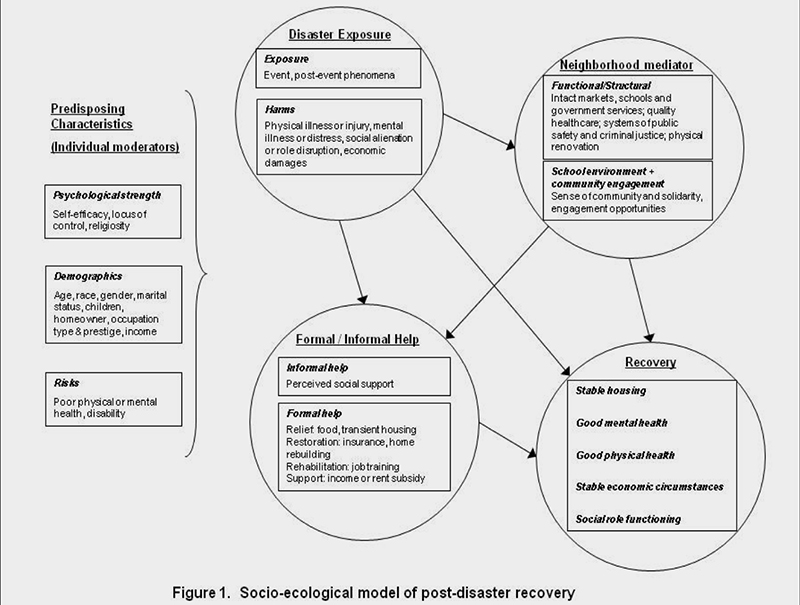Demographic and Health Disparities in Recovery from Hurricane Katrina
The NIH-funded KATRINA@10 Program consists of an interrelated set of three primary data collection projects that focus on specific sub-populations who were uniquely affected by Hurricane Katrina; two secondary analyses of data that are more broadly representative of the overall affected population; and three cores to support the set of Research Projects. A central strength of the Center's research is that it entails both depth and breadth in its assessment of recovery at the 10-year anniversary of one of the worst disasters in American history.
Co-Principal Investigators
- Mark VanLandingham, Ph.D. (Contact PI)
- David Abramson, Ph.D.
- Mary Waters, Ph.D.
Advisory Board
- Roberta Avila, Executive Director. STEPS Coalition
- Carol Bebelle, M.A., Executive Director. Ashe Cultural Arts Center
- Michael Cunningham, Ph.D., Professor, Tulane University Psychology Department
- Cyndi Nguyen, Executive Director, VIET
- John-Hoa Nguyen, Business Leader, People's Reality, Inc.
- Reginald Parquet, Ph.D., Clinical Assistant Professor, Tulane University School of Social Work
- Steve Picou, Ph.D., Director, Coastal Resource and Resiliency Center
- Paul Rainwater, Consultant, Cornerstone Government Affairs, former Executive Director, Louisiana Recovery Authority
- Irwin Redlener, M.D., Director, National Center for Disaster Preparedness at the Earth Institute
- Allison Truitt, Ph.D., Assistant Professor, Tulane University Department of Anthropology
- Research Projects
- Project #1: Resilience in Survivors of Katrina Project (RISK) Lead: Mary Waters, Ph.D. Research
- Project #2: Gulf Coast Child and Family Health Study (GCAFH) Lead: David Abramson, Ph.D. Research
- Project #3: Katrina Impacts on Vietnamese Americans in New Orleans (KATIVA NOLA) Lead: Mark VanLandingham, Ph.D. Research
- Project #4: Broad Impacts (DNORS ANALYSIS) Lead: Narayan Sastry, Ph.D. Research
- Project #5: New Demographics (NEW NOLA) Lead: Elizabeth Fussell, Ph.D. Administrative
Cores
- Core A (Administrative) Lead: Mark VanLandingham, Ph.D.
- Core B (Data Collection) Lead: David Abramson, Ph.D.
- Core C (Data Management and Dissemination) Lead: Philip Anglewicz, Ph.D.
While the individual Research Projects are described in detail in the above links, there are several cross-cutting research activities to answer key research questions. These questions include:
- How well does our theoretical model predict recovery across the three cohort studies (RP 1-3)?
- How do trajectories of long-term recovery differ among and within these highly-affected but distinct sub-populations?
- How do these specific trajectories of recovery compare with those of well-studied mainstream populations?
- How do the effects of pre-disposing factors (such as poverty) and degree-of-impact (such as flooding depth) vary among our three special sub-populations?
- How do interpretations of the disaster, resilience, and recovery differ among respondents from our three special sub-populations?
- What are the determinants of long-term recovery in domains such as mental and physical health, socio-economic status, and community and social roles? How are these domains related to each other across individuals and across sub-populations?

We believe that these overarching analyses advance disaster studies beyond what the individual projects could achieve were they not linked under this Program. To pursue this goal, we employ a unifying theoretical framework across our three cohorts. The Socio-ecological Model of Disaster Recovery was developed by one of our PIs and his colleagues (Abramson et al. 2010). Some several illustrative examples are below.
- Refinement, validation, and testing of a common underlying and unifying theoretical model: The analysis of data from our three cohort studies are informed by a common theoretical model developed by Program MPI David Abramson. The validation and testing of this promising model across a wide range of populations would be highly unlikely to take place from a series of stand-alone studies.
- Employment of compatible longitudinal measures across the duration of the post-Katrina period to assess resilience and recovery trajectories and processes. All three cohort studies (RP 1-3) benefit from extensive measures of health and well-being during the decade following Katrina; and the Program allows for a synthesis of how the three cohorts have fared over the course of the decade; as well as an analysis of disparities within the cohorts. Data from RP5 will also be incorporated into these analyses (see below). Such a synthesis would be highly unlikely to take place from a series of stand-alone studies.
- Employment of identical measures across three cohorts at T10 to assess differentials in the long-term consequences of a disaster: Collecting state-of-the-art measures across three ongoing cohorts of sub-populations uniquely-affected by Katrina would be unfeasible in a series of stand-alone projects.
- Joint qualitative analyses: Cross-cutting qualitative data includes a) Key Informant interviews of community leaders from the Vietnamese American and African American communities; b) a sub-set of common guidelines for household heads from our three specialized populations of interest (African American women who are first generation college students, from RISK; disadvantaged families who ended up in FEMA provided housing from GCAFH; and first generation Vietnamese American immigrants, from KATIVA NOLA); and c) a small set of common questions directed at youth (age 18-24) in all three cohorts that will be used to support formative qualitative work to extend our common socio-ecological framework of recovery to youth.
